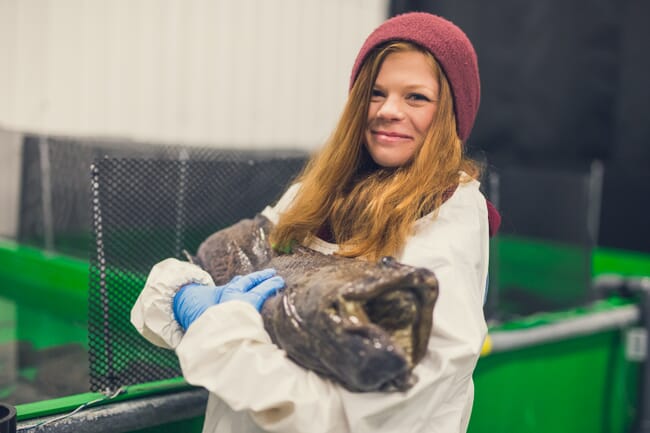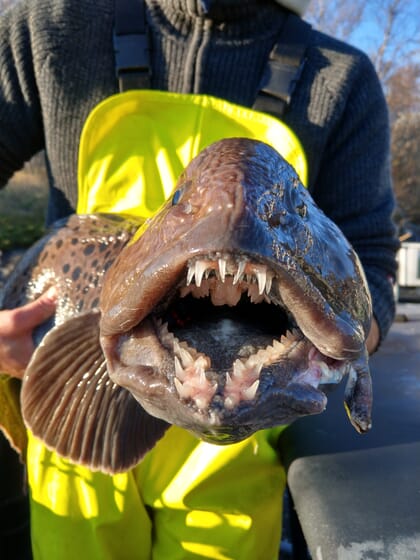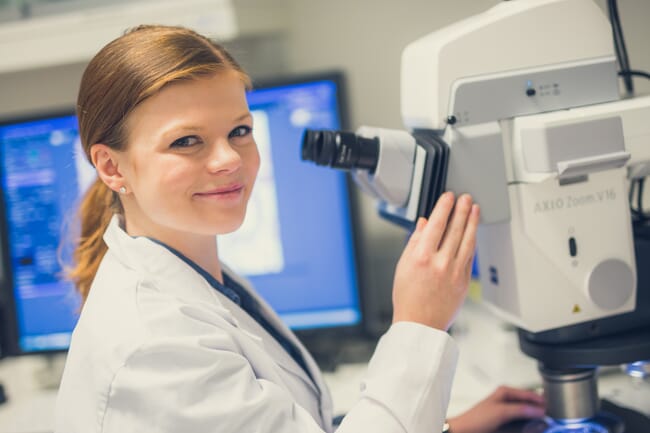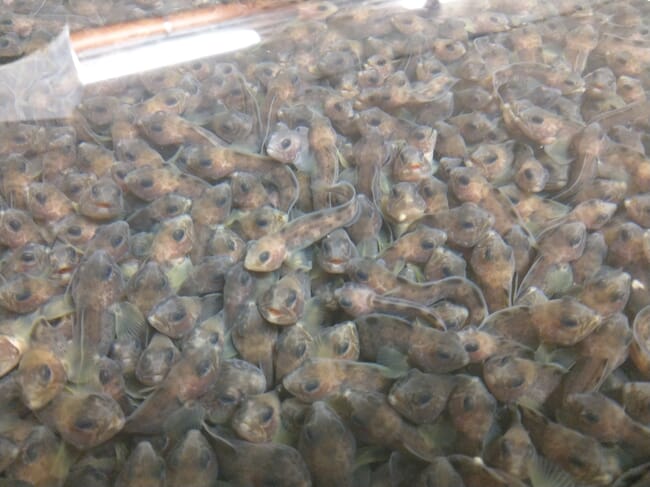What does you project involve?
I’m researching alternative feed ingredients for the spotted wolf fish (Anarhichas minor) in aquaculture in collaboration with Aminor AS, the only commercial producer of the species in the world.

© Frida Bringslimark/Bodo i Vinden
What’s the scale of wolf fish production at the moment?
Aminor will produce its first large-scale harvest – of around 80 tonnes – next year, by which time the fish they hatched in 2015 will be 4-4.5 kg. They plan to produce a minimum of 60 litres of roe in 2018 (from both summer and winter spawning), which will enable a harvest of 500 tonnes of fish in 2021.
What potential do wolf fish possess for aquaculture?
Spotted wolf fish exhibit many traits that makes them a suitable aquaculture species. There is limited competition with the wild-caught product and fillet yield is high. The growth rate is good, even at low temperatures, and is quicker than for both the common wolf fish and blue wolf fish. The species shows few signs of stress under culture conditions and is very disease resistant, as well as being able to tolerate fluctuations in environmental parameters such as salinity. The whole life cycle can be produced in captivity and light manipulation can be applied to control reproduction. Spotted wolf fish larvae have a fully functional digestive system on hatching, enabling them to be fed immediately on formulated diets. This makes it possible to avoid the labour intensive and costly use of live feeds. They are also suitable for intensive cultivation due to their tolerance of high stocking densities. Finally, the skin can also be used in the same way as leather, which could be an interesting by-product to be used in the production of shoes, handbags and so on.
Are there any major challenges to growing wolf fish?
Good water quality is essential for the incubation of the eggs as well as for the larvae. Because of this Aminor has invested millions in a new cooling facility and filters to ensure stable cold water (4oC) throughout this phase. This is also critical for ensuring success with eggs following spawning in summer.

© Oliver Sandaa , Aminor AS
Why should the Norwegian industry be looking to diversify?
Norway produces 1.3 million tonnes of food from aquaculture annually, 93 percent of which is Atlantic salmon. This means that there is a huge potential for diversification of the industry by incorporating new species, to explore new markets and to ensure continued growth of the industry.
What other areas might be suitable for spotted wolf fish production?
Being an Arctic species, spotted wolf fish require low temperatures to ensure optimal growth and development. Any area that has access to cold, clean water should be suitable for wolf fish production.
Why did you decide to research wolf fish diets?
The nutritional requirements of spotted wolf fish are still not fully understood and this is one of the areas where more research is needed in order to optimise production. As fishmeal and fish oil are becoming limited resources, the aquaculture industry will also become increasingly dependent on alternative feed resources in the future. Because of this, investigating the use of alternative feed resources for spotted wolf fish is a key factor for determining the potential of their cultivation as a future industry in Norway.
What has your research involved?
Our current project involves studying the effects of alternative feed ingredients, specifically the use of microalgae and plant-based ingredients, in the production of spotted wolf fish juveniles. In the initial stage of the project we evaluated the effects of replacing fishmeal-based protein with microalgae. Later, we replaced a much larger part of the fishmeal with both plant-based ingredients and microalgae.
What results have you had from your study to date?
The results of our project will be published during 2018, but from our preliminary analysis, the spotted wolf fish seems to tolerate both microalgae and plant-based ingredients very well.

© Frida Bringslimark/Bodo i Vinden
What next steps would you like to take next?
Our initial trials using alternative feed ingredients for spotted wolf fish seem promising, but there is still more work that needs to be done in order to create optimised diets for the species. Increased understanding of their nutritional requirements would make it possible to tailor the dietary composition to ensure optimal growth in captivity.
How might your research impact the future culture of wolf fish?
The project will provide information about the robustness of utilising ingredients from different sources, such as microalgae and plant ingredients. Feed is important in any intensive production of fish because production costs are closely linked with feed utilisation. From other farmed carnivorous fish we know that feed ingredients have an impact on fish health. It is therefore important to know the tolerance and potential to utilize different feed ingredients.

© Oliver Sadnaa, Aminor
Who is involved in the project?
Our project group consists of me, my supervisors Ørjan Hagen (associate professor), Oddvar Ottesen (professor) and Mette Sørensen (professor) as well as two masters’ students, Ann Kristin Ulset and Ingeborg Helene Johnsen and one bachelor student, Sven Kaizer. In addition to our group we also have a second group at Nord University working with the reproduction of spotted wolf fish, led by José Beirao (PhD).


